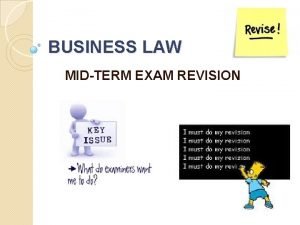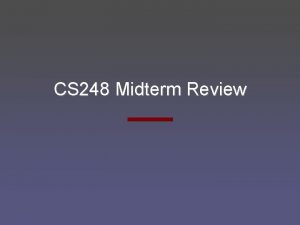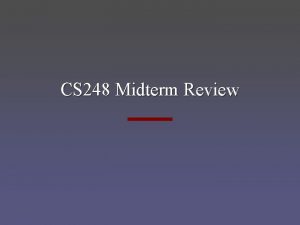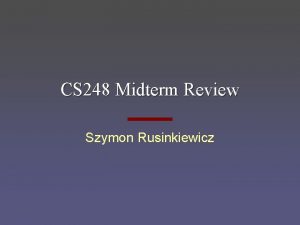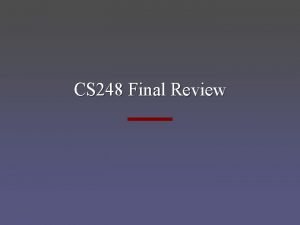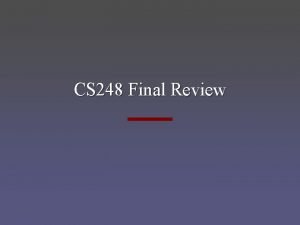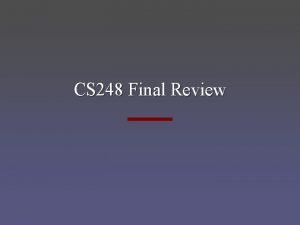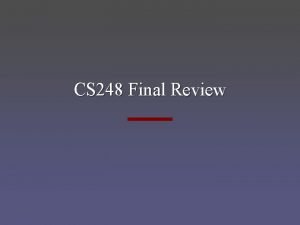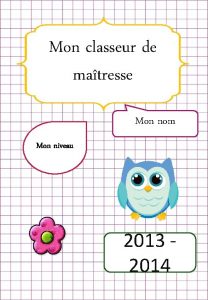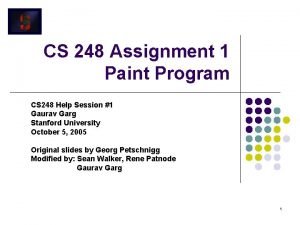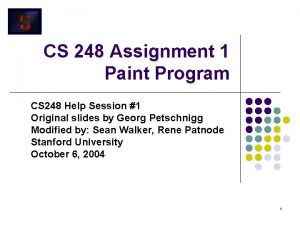CS 248 Midterm Review CS 248 Midterm Mon


















- Slides: 18

CS 248 Midterm Review

CS 248 Midterm • • Mon, November 5, 7 -9 pm, Terman Aud Mon, November 5, 3 -5 pm, Gates 392 Mostly “short answer” questions Covers through Thursday’s lecture

Raster Displays, Resolution, Perception • Measures of spatial resolution – physical vs. addressable resolution • CRTs – 3 phosphors for “red”, “green”, and “blue” – Triads and shadow mask

Human spatial frequency sensitivity – Sensitivity highest in fovea – Frequency sensitivity – Phase sensitivity (Vernier acuity) – Temporal sensitivity • Flicker (50 -70 Hz) • Perceived motion – 12 Hz = cartoons, 24 Hz = film, 60 Hz = video

Raster Displays, Resolution, Perception • Human intensity sensitivity – Response to intensity is nonlinear – Gamma in cameras, CRTs – Gamma correction • Dithering – Trade off spatial resolution for intensity res.

Raster Displays, Resolution, Perception • Sample (easy) questions: 1. A scene is photographed with a TV camera with gamma=0. 5 and displayed on a CRT with gamma=2. 4. If we want system gamma to be 1. 0, we should do gamma correction with what exponent? 2. You are doing clustered-dot dithering on an image for output on a 300 dpi laser printer. If you need at least 75 dpi “effective” resolution, how many shades of gray can you output?

Color • Perception of color – Humans are trichromat • Three cones sensitive to “red”, “green”, and “blue” – Overlapping response curves • Color matching – Color matching experiment – Metamers

Color spaces • Linear colorspaces – , , space (perceptual stimulous) – R, G, B space – X, Y, Z space • Non-linear colorspaces – HSV • Spectral locus • Gamut of reproducible colors

Color Sample questions: 1. Can your printer necessarily reproduce all colors that your monitor can reproduce if they both use RGB primaries? 2. You are wearing glasses that block all light from the lower third of the visible spectrum, what color does the world look tinted?

Sampling and Antialiasing • The sampling and reconstruction pipeline: – Prefiltering – Sampling – Resampling – Reconstruction • Aliasing – Frequency domain interpretation

Sampling and Antialiasing • Filtering and convolution • Prefiltering vs. postfiltering • Desirable filters for antialiasing – Box, pyramid, gaussian, sync • Methods of antialiasing – Supersampling – Analytic antialiasing

Sampling and Antialiasing Sample questions: 1. What is the result of convolving a 1 -D box filter with itself? 2. If we want to be sure to avoid aliasing, should we choose a filter slightly narrower or slightly wider than a pixel?

Digital Compositing • The compositing approximation – Conditions for validity • Deriving alpha mattes – Blue screen – Computing while rendering • Compositing algebra

Digital Compositing Sample question: You are doing the special effects for a movie, and need to composite a computer generated object over a live background. Why should you use an 8 -bit alpha matte rather than a binary (1 -bit) matte, even if the computer-generated object is fully opaque?

Rasterization • Rasterization of lines – Definition of “one-pixel-thick” line – which points get rasterized? • Rasterization of polygons – Only pixels in the polygon • Supersampling – Patterns

Rasterization • Sample question: – If you rasterized this line, which pixels would get turned on?

Transformations • Homogeneous coordinates – why? • Matrices rotation, translation, scale, shear in 2 D, 3 D – Know the form of each kind • Composing transformations – multiply matrices in reverse order

Transformations Sample question: What is the transformation between vector 1 and vector 2?
 Comp 248 midterm
Comp 248 midterm Comp 248 midterm
Comp 248 midterm Ap chemistry midterm
Ap chemistry midterm Whap midterm review
Whap midterm review Biology midterm review
Biology midterm review Which substance can be decomposed chemically
Which substance can be decomposed chemically Algebra 2 midterm exam
Algebra 2 midterm exam Marketing midterm review
Marketing midterm review Geometry midterm exam
Geometry midterm exam Business law midterm answers
Business law midterm answers Mnemonic for reticular formation
Mnemonic for reticular formation Spanish 2 midterm practice test
Spanish 2 midterm practice test Global 9 midterm review
Global 9 midterm review Oligotrophic definition apes
Oligotrophic definition apes Algebra 1 midterm review
Algebra 1 midterm review World history b semester exam review practice
World history b semester exam review practice English 1 midterm exam answers
English 1 midterm exam answers Trig midterm review
Trig midterm review Je veux te louer seigneur encore et de tout mon coeur
Je veux te louer seigneur encore et de tout mon coeur









